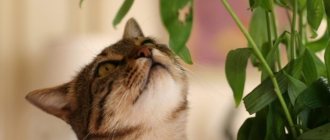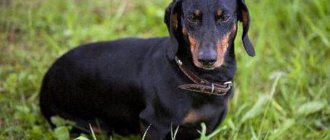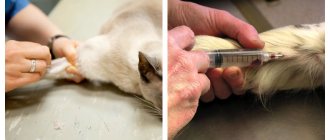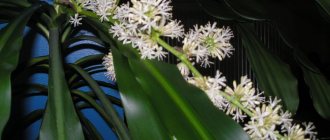Many cats are partial to indoor plants. Moreover, they often like to taste something that has an attractive smell to them. Sometimes owners don’t even think that plants growing on windowsills can become a real threat to the health and life of their pets.
Let's look at how plants are dangerous and which ones are completely poisonous for cats; Are flowers in bouquets dangerous? what are the symptoms of a cat leaving and how to provide first aid.
Garden and field plants
Spring Adonis (Adonis vernalis)
all parts of the plant
Wolfsbane, or fighter (Aconitum)
all parts of the plant
systemic toxic effect
Aquilegia (catchment)
seeds
Arisema triphyllum
swelling of the larynx, loss of coordination of movements and acute heart failure
Arum (Arum)
toxic due to alkaloid content
Periwinkle (Vinca)
hallucinogen
Begonia
the whole plant contains oxalic acid,
when swallowed, it burns the mucous membrane of the mouth, causing swelling of the larynx and oral mucosa.
Autumn colchicum (Colchicum autumnale)
all parts of the plant
allergic dermatitis, toxic poisoning, impaired coordination of movements, heart failure
Belladonna (belladonna)
alkaloids are found in all parts of plants
nausea, vomiting, drowsiness
White locust (false locust) (Robínia pseudoacácia)
bark
vomiting, diarrhea, cramps, abdominal pain, heart, kidney and pulmonary failure
Henbane (Hyoscýamus)
systemic toxicity
Spring whiteflower (Galanthus vernus)
leaves, peduncles, bulbs
allergic dermatitis, vomiting, diarrhea, convulsions, renal, heart and pulmonary failure, damage to the nervous system
Euonymus
whole plant
Biota (Biota orientalis), or oriental thuja (Thuja orientalis)
swelling of the larynx, loss of coordination of movements and acute heart failure
Hemlock (Cicuta virosa) (gorigolov, hemlock, cat parsley, dog angelica, pig louse, poisonous wech, wood pig, water rabies, omeg, omezhnik, mudnik)
The entire plant is poisonous.
Hemlock smells like carrots, and the rhizome tastes like radish. The root resin contains cicutoxin. Nausea, vomiting and colic, dizziness, unsteady gait, foam at the mouth. The pupils are dilated, epileptoid seizures and convulsions can result in paralysis and death. 100-200 g of rhizome is enough to kill a cow, and 50-100 g will kill a sheep. According to some sources, Socrates was poisoned with the poison of this particular plant.
Hogweed (Heracleum)
severe skin burns
Three-pointed, holly-leaved maiden grape (tetrastigma, indoor grape) (Parthenocíssus tricuspidáta)
laryngeal edema, vomiting, diarrhea, convulsions, impaired coordination of movements and acute heart failure
Wolf's bast (common wolfberry, or deadly wolfberry) (Dáphne mezéreum)
The bark (bast), leaves, flowers, and fruits are highly poisonous.
systemic toxicity
Helleborus (helleborus, Christmas rose)
the whole plant, especially the root and leaves,
irritation of mucous membranes, vomiting, diarrhea, heart failure
Hairy heliotrope (Heliotropium lasiocarpum)
leaves, stems and seeds
Geranium, (Pelargonium, Pelargonium), especially blood-red geranium (Wolf's foot)
indigestion
Wisteria, also known as Wisteria
vomiting, diarrhea
Gloriosa
deadly poisonous
Hydrangea
The leaves and flowers contain cyanide ions, which exhibit their poisonous effect upon contact with saliva and water.
vomiting, diarrhea, tremors, cardiac, renal and pulmonary failure
Delphinium, also known as larkspur, spur (Delphínium)
vomiting, diarrhea, convulsions, cardiac, renal and pulmonary failure
Datura
alkaloids are found in all parts of plants
nausea, vomiting, drowsiness
Fragrant tobacco
alkaloids are found in all parts of plants
nausea, vomiting, drowsiness
Jasmine (Jasmínum) or Mock orange (Philadélphus)
systemic toxicity
Honeysuckle (Lonicera)
swelling of the larynx
St. John's wort (Hypericum)
nervous system damage
Honeysuckle, or honeysuckle honeysuckle, or goat honeysuckle, or fragrant honeysuckle (Lonicera caprifolium)
Dogwood (Cornus)
swelling of the larynx
Clematis, also known as clematis
vomiting, diarrhea
Castor bean (Ricinus communis)
vomiting, diarrhea
Hemp (Cannabis)
hallucinogen
Horse chestnut or acorn plant (Aesculus)
seedlings, nuts, seeds
vomiting, diarrhea, convulsions, heart, kidney and pulmonary failure
Crocus, or saffron (Crócus)
whole plant
vomiting, diarrhea
Swimsuit (Trollius)
roots
Lakonos, or phytolacca (Phytolacca americana and Phytolacca acinosa)
vomiting, diarrhea
Lysichiton americanum
vomiting, diarrhea
Lupine (Lupinus)
systemic toxicity
Buttercups (Ranunculus)
systemic toxicity
Poppy (Papáver)
hallucinogen
Foxglove (Digitalis)
leaves
vomiting, diarrhea, convulsions, renal and pulmonary failure, cardiac dysfunction
Mistletoe, or oakberries, or bird glue (Víscum)
disorders of the heart and central nervous system
Oleander (Nerium oleander)
the whole plant, especially the leaves,
systemic toxic effects, cardiac dysfunction
Ferns (Polypodiophyta)
vomiting, diarrhea
Shepherd's Purse or Purse (Capsella)
Primroses or Primroses (Primuláceae), including primrose (Prímula)
juice
burn and allergic dermatitis
Petunias
poisonous alkaloids are found in all parts of plants
vomiting, diarrhea, drowsiness
Tansy (Tanacetum)
During flowering, tansy inflorescences contain alkaloids (0.04-0.5%), glycosides, and organic acids (tanacetic and gallic). The plant is toxic due to the presence of thujone.
Tauride wormwood (Artemisia taurica Willd)
aboveground parts
Orange tree, also known as bitter orange, bigardia, bitter orange (Citrus aurantium)
vomiting, diarrhea, convulsions, cardiac, renal and pulmonary failure
Meadow lumbago (Pulsatilla pratensis)
juice
Extract from the leaves has a strong bactericidal and fungicidal effect, has a sedative effect and can be used as a hypnotic, analgesic and expectorant, and stimulates liver function. Used in veterinary medicine. The juice can cause skin diseases.
Rhubarb (Rhéum)
leaves
systemic toxic effect
Rhododendron
leaves
cardiovascular disorders, diarrhea and vomiting
Fragrant rue, or fragrant rue (Ruta graveolens)
inflammation and burns of the oral cavity
Evergreen boxwood, or buxus (Búxus)
systemic toxic effect, up to death
Tobacco (Nicotiana)
leaves
swelling of the larynx, impaired coordination of movements and acute heart failure
Yew berry, or greenery, negtyuchka (Caucasian), mahogany (Táxus baccáta)
bark, leaves, seeds
vomiting, diarrhea, acute heart failure
Physalis
vomiting, diarrhea, convulsions, cardiac, renal and pulmonary failure
Chlorophytum
allergic dermatitis, but not in all cats
Hellebore (Verátrum)
leaves, roots, seeds
vomiting, diarrhea, convulsions, heart, kidney and pulmonary failure, even death
Celandine, or Warthog (Chelidonium)
contains alkaloids: homochelidonine, chelerythrine, sanguinarine, protopine, etc.
Convulsions, increased intestinal motility and salivary secretion, hallucinations. In livestock, celandine causes poisoning and severe inflammation of the stomach and intestines. Pigs, for example, after eating celandine, not only lose strength, but also become noticeably deaf.
More poisonous plants:
potatoes (shoots), onions, tomato (stem, leaves and green fruits), apple (seeds), elderberry (berries), dandelion (the milky sap of old plants is dangerous).
Oats and other grains for cats or cat grass
The cat plant group consists primarily of oats (as well as wheat, barley and rye). This is not a typical houseplant because it is not usually grown in an apartment, but we can sow it in a pot especially for our pet.
This shouldn't be a big problem for us, since ready-made seeds or seed mixtures (often with a container and substrate) can be found in almost every pet store. Oats will be a safe snack for your cat and will distract his attention from other potted plants.
These are oats and other grains that are sometimes sold as "cat grass", although there are other plants under this name.
Various plants are sold under the slogan "cat grass". These include grains such as oats, rye or wheat. Rice. RadioMaxx - pixabay.com
Yucca
Yucca is a fairly large houseplant that is popular because it is easy to grow, beautiful in appearance, and has low requirements. You will recognize it by its trunk, overgrown with leaves arranged in a trail. Are you wondering if yucca is poisonous to cats? Unfortunately, yes, so if it decorates your home, get rid of it as soon as possible.
Until recently, it was believed that only garden yucca was harmful to cats, but it turns out that the house plant is also toxic. The dangerous ingredient is saponins. Ingestion of this plant by a cat can lead to vomiting, which in turn leads to dehydration, which is extremely dangerous.
- Yucca is dangerous for cats because of its saponins. Ingestion of the plant may cause vomiting, and it will dehydrate your pet.











